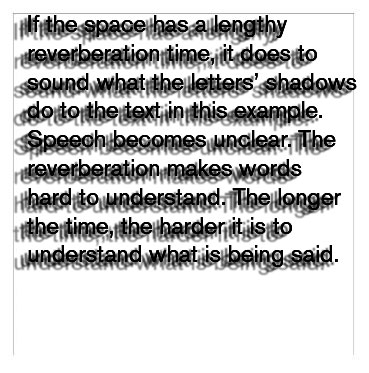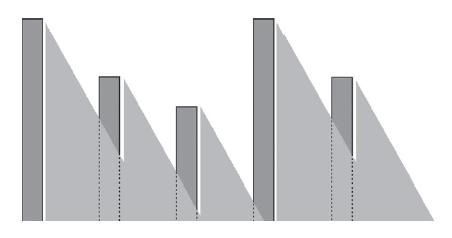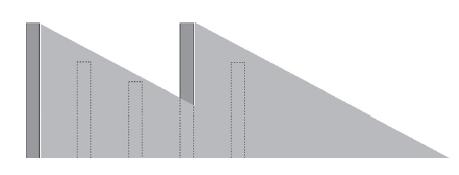You’ll have absolutely no problem reading this text. The font is easy to read and the contrast is sufficient.
But what if the paper got wet. The ink would spread all across the page and the letters would run together and become indistinct blobs, barely recognizable as letters? What if reading were to become a chore and you couldn’t tell what all the words were? You’d have to guess some of the words and as understanding the thought behind the text becomes more and more difficult, you tire of reading easily.

When the listening conditions are good, listening is as easy as reading this text. Listening is a pleasure adn you can concentrate on following the speakers train of thought instead of having to stop to think what that word you just heard was.
Unfortuantely listening conditions are rarely ideal. Various disturbances interfere with listening. When there’s enough interference listening is like reading a smudgy text. It’s tiring, which quickly decreases our ability to take in new things.
Various factors can interfere with listening. These include environmental attributes, the structure of the space you’re in, surface materials used, etc. Some interference is caused by people.
Following are some phenomena that interfere with listening and their effects are illustrated using images.
Reverberation
The most common factor that interferes with listening is a long reverberation time. Reverberation is created when a sound produced in a sapce is reflected off surfaces, like walls, teh floor or the ceiling. These reflections are re-reflected and the space is filled with sound that gradually decreases in volume. The time it takes for this sound in the space to decrease in volume down to 60 decibels (practically silence) after the sound source is extinguished is its reverberation time.

Reverberation does to sound what has been done to the text in the above image.
Speech consists of short sound impulses which vary in volume. Vowels contain a lot of sound energy, but sound energy density level is much smaller in ost consonants. For example the sound for H is just a soft puff of air.
When the reverberation time is short enough, all sounds are distinct and words easy to understand. In a space with a lot of echo, teh reverberation of the stronger sounds makes it harder to hear the sounds with a lower energy density, so some of the information conveyed by speech is lost.

The graph describes the variation in volume between the phones that a word consists of. The shadow after the pillar illustrates the sound caused by reverberation. When the reverberation time is short enough, the reverberation of the stronger phones has time to die down before the next phone, so all the phones the word consists of are heard distinctly.

If the reverberation time is long, the reverberation of the stronger phones engulf the weaker phones. Only a part of the word is heard.
What the suitable reverberation time is depends on what the space is used for. In spaces where spoken communication plays an important role, a good reverberation time is approximately 0.5 seconds. These include e.g. schools, kindergartens, offices and hospitals. Spaces built for palaying and listening to music benefit from e reverberation time of 1.5-2.0 seconds.
The size and shape of hte space have en impact on the reverberation time, as do the damping factor of the materials used in the surfaces and furnishings. Materials with a high damping factor, such as mineral wool sheets and various perforated boards decrease reverberation time. Hard and smooth surfaces such as concrete, glass or wallboard increase it.
Reverberation time can is shortened by covering up reflective surfaces with materials that dampen sound. The best material for dampening sound is acoustic board, which is made especially for this purpose, but all soft surfaces like rugs, carpets, furniture upholstery and even people in the room eat up sound.
Reverberation time, like all phenomena in the world of sound, is dependent on frequency. Different sound frequencies are reflected and dampened differently, depending on the surface’s attributes. When taking an accurate reverberation time measurement, results are usually gsorted by frequency band. The final reverberation time is usually an average of all the measured frequency bands.
Background noise
Another factor that interferes with listening is background noise. Background noise may be e.g. the humming of the ventilation, sounds caused by various machines and devices and traffic noise. THe louder it gets, the more it interferes with hearing. The frequency range of the background noise also has an impact on how much interference it causes. Noise outside the human hearing range does not interfere, but may have other adverse effects.

Background noise is like trying to read a text with a busy background.
In an echoey space background noise also reverberates and thus causes a worse interference.
Other people’s voices
As factors that interfere with listening other people’s voices is the worst. If the voices we hear speak softly enough and are far enough, we can hear what the person we are talking to is saying. The louder the other voices are, the harder it is to discern what the person we are conversing with is saying.


The closer the interference is to the speech we are trying to listen to, the more it interferes.
When a student in a class is hearing impaired, an effort should be made to ensure that people in class speak one at a time. Situations where the class is divided into workgroups is usually totally impossible for the hearing impaired student. The group the hearing impaired student is in should be provided with its own quiet space where the voices of the other groups don’t interfere with listening to the other members fo his or her group.
Jukka Rasa, Kuuloliitto ry.




